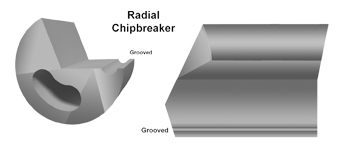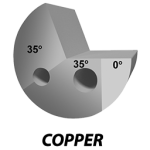Tech Support
We have a dedicated staff of experts with over 85 years of combined experience to assist the customer with all of their special requirements. At the beginning phase of an engineering project, give us a call to discuss the process sequences required to avoid unnecessary problems in the future. Contact our engineering staff if you are experiencing any gundrilling problems or have questions. We have solutions.
Deep Hole Drilling
Deep hole drilling was first developed for the manufacturing of firearms, hence the name gundrilling. Originally a time-consuming and expensive process, technological advances have made it a highly efficient manufacturing process utilized in all metal cutting industries, including automotive, aircraft, aerospace, construction, medical, tool and die, petrol chemical, hydraulics, pneumatics and more. Gundrilling is an ideal solution for most deep hole and high precision drilling projects. This operation produces accurate, repeatable holes with excellent surface finishes. Gundrills hold location to precise tolerances, are sized to exact specifications, produce burr-free holes and can be formed to produce specific shapes in blind holes and bottom forming with a minimum of machine adaptation. These systems can be easily integrated with CNC machining centers, lathes and milling machines for a relatively small investment, making it affordable for large or small shops with production requirements varying from one piece to hundreds of thousands.
Nose Grinds
Nose geometries are one of the most important characteristics of successful hole making. There are numerous nose grinds that have been established by end users to critique applications. There are a handful of standard general purpose grinds which are industry standard and have good success for a given material. Modifications are made to these due to material hardness, softness, tinsel strengths, lack of coolant pressure or lubricity, etc.
The N-8, N-4, N-73, and Facet grinds are Industry Standard Grinds while bottom forming, corner radius, full spherical radius, and flat bottom may also be produced in a single pass. Capabilities to blue print specifications may be examined through our engineering department.
The center design of our gundrills allows for a wide range of Nose Grinds from a full spherical radius to a flat bottom design. The Nose Grind angles are important in achieving optimal results. Angles can be modified to improve the flushing action of the high pressure oil and to improve chip control and removal. Specific grinds have been developed for severe applications such as exit breakouts and interrupted or angular entries. Some of the most popular Nose Grind configurations are shown here. Bottom forming such as a corner radius, full spherical radius, and flat bottom may also be produced in a single pass. Capabilities to blue print specifications may be examined through our engineering department. Some special grinds may be dictated by part prints calling for a corner radius, full spherical radius, flat bottom, step drills, pilot non-cutting step drills, chip breakers, etc. Below are examples of common industry standard nose grinds, click on your choice for more details… which can be reproduced on the Model “B” Sharpening Fixture.
Chip Breakers
Chip Breakers are used when chip wrapping occurs. This usually occurs when entering uneven surfaces, intersections, an existing hole, a pilot hole with a cone shape, or with unobtainable feeds or speeds to name a few. Chip Breakers are generally used to break string type chips often attributed to a gummy material or when machines limit the surface footage necessary to generate the heat needed to break a chip. There are two types of Chip Breakers shown below.


Determining Time To Re-grind
Reproducing a factory grind can be obtained in your facility with the Eldorado Model “B” sharpening fixture or a CNC grinder such as an Avyac or similar equipment. Additionally, DME offers a re-grinding service with a 24 hour turn around. Determining when a tool has reached the point when it’s time to re-sharpen takes a visual examination of the cutting edge. Inspecting the cutting edge will determine if the running parameters are adequate for optimal results.
Contours
Contours, or bearing pads, are the actual surfaces that make contact with the material inside of the hole. This produces the burnishing effect which contributes to the balancing of the tool while in the cut. Various locations of these pads determine the amount of heat generated and allow for control of material distortion during the cut. Some pads like the R-1, are not 180 degrees apart (non micable) they allow for a much freer cutting tool.

Drivers
Drivers are manufactured from various materials depending on the hardness desired by a particular application. The spindles or tool holders determine the locking mechanisms prescribed for individual applications. The most common and standard is a two degree tapered flat in an under-cut centered in the driver and two tapered flats 90 degrees apart with a 2 degree taper. There are many variations as with machine stroke limitations; small diameter deep hole applications require longer drivers (extensions) to enable shorter tip and tube lengths. This allows for maximum surface feet per minute minimizing the whip factor. Many machine manufacturers dictate the drivers OD and lengths depending on their geographic location hence, metric or imperil.
Driver design is important because of the high speeds and pressures used in the gundrilling process. Maximizing the gundrill driver length improves rigidity and concentricity.
Coatings
Coatings are available to obtain ID surface finishes as low as 10Ra, depending on the material being drilled. Conditions such as water soluble coolants, which occasionally do not have the lubricity necessary to allow the tool to cut freely, require coating. Many new coatings are available for most materials and occasionally generate better tool life. The most common coatings are TiN, TiALN, TiCN and Alcrona Pro. Coatings provide a small amount of extended tool life on a gundrill. The manufacturing process dictates the removal of the head before the coating process because of the high temperatures present in the vessel. These temperatures would jeopardize the integrity of a braze joint. The head is reattached and the coating is removed from the nose end (inside and outside angles).
Collet Inserts
Collet inserts are precision collets that fit into the nose of the Model “B” Sharpening Fixture and hold a range of diameters precisely in the fixture.
Feeds & Speeds Charts
Included in this chart are materials based on mill run specifications, and give “starting” parameters. If the hardness of a material is outside of mill specifications the SFM needs to be reduced. When in doubt, contact our technical staff for advice. Always consult the maximum unsupported length chart before setting up an application.
Calculations & Formulas
Certain constants must be maintained and calculated to obtain optimum running conditions. Contact our technical staff if these parameters are out of your capabilities for alternate parameters.
Maximum Unsupported Length Chart
Maintaining the proper unsupported length on a gundrill is critical to the success of an application. While a tool may not appear to be whipping, once the in-feed is actuated the tool can whip causing failure. This unsupported length chart will help the customer determine the safest RPM (SFM) for a given diameter and length.
Coolants
The use of oil as a coolant yields the best results. Oils with a minimum of 2-1/2% sulfur provide an adequate anti-weld agent. A minimum of 4-1/2% chlorine works as a lubricant. Higher levels of one or the other are offered for specific applications. An example is 718 Inconel and some 300 series stainless which achieve better finishes and tool life with 10% chlorine content. Every oil manufacturer has some type of gundrill oil to offer. Water soluble synthetics and semi-synthetic coolants are becoming more used. The cost of oil, health issues, and disposal costs have made the use of oils unfavorable. The downside of water soluble coolants is a 30%-40% loss in tool life. Manageability is a major issue; a 10%-12% concentration is recommended and constant monitoring of the system is needed to maintain the desired specifications. Tramp oils in a system need to be controlled and EP packages recharged at predetermined intervals.
Filtration
5–10 micron filtration is recommended for gundrilling to prevent material fragments from re-circulating back through the drill and potentially causing excessive abrasive forces to the outside pads (contours) and cutting edge of the tool. There is also a detrimental effect on a piston type pump.
Troubleshooting Chart
This troubleshooting chart was derived from common malfunction which may occur during the drilling cycle. It covers machine set-up, GDIs, sharpening, coolant pressures, oversized and undersized holes, etc. If your problem is not diagnosed or fixed from this chart a call should be placed to our technical support team.








